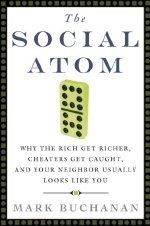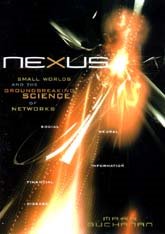This post really has little to do with The Social Atom, but I've had no time to blog anything today, as I've been occupied with a last-minute article on some recent physics research. Physicists are getting ever closer to building material systems that will coax photons, the quantum particles of light, to interact with one another. Ordinarily, that never happens; flashlight beams, for example, just pass through one another. But it turns out that with some really tricky quantum optics, it should be possible to effect (which quantum theory says is possible).
You may ask -- why even try? I'll get to that.
The bizarre things researchers are developing to achieve this illustrate the way science leads in directions that no one could possibly imagine beforehand; truth really is stranger than fiction. One prominent proposal, for example, involves lasers illuminating thin films of diamond, within which specially-chosen atoms have been embedded amidst a precise pattern of tiny, drilled microholes. Without getting into the details, the quantum physics of this weird system leads is an array of cavities which can trap single photons. With the cavities arranged in precise geometric arrays, the photons in neighboring cavities will interact fairly strongly with one another, and so what you get is a system akin to a collection of interacting photons. It hasn't been done yet in the lab, but the principles are so well understood that it almost certainly will be done in a few years.
Now back to the why. Why do this? There are a couple of reasons, besides it's being just good fun and a challenge leading to new physics (which I think is probably the most important reason, by the way). First, there's good reason for expecting that interacting photons would be exceedingly useful for doing quantum information processing; i.e. as parts of quantum computers. But well before that, physicists also expect they'll be able to use these photon systems as "quantum simulators" to do virtual experiments mimicking just about any kind of particle system you like.
When we think of simulation we ordinarily think of simulation by computer; but if you think about it, simulation really has nothing to do with computers. It really means using something that is simpler or faster or easier to use to study the behavior of something else, under conditions when you have confidence that the two things should work similarly, so you can learn about the one from the other. Theorists have shown that interacting photon systems could be tuned to dial up just about any physics you like -- any details about the interactions between particles -- and so could be used to do virtual experiments for all kinds of hypotheticl materials, even ones that don't exist.
Curiously, I just came across a review in Nature, written by my former colleague Phil Ball, of two new books on simulation in the social sciences. As the review notes,
..these two books are part of an important trend in the social sciences. Both argue for the value of agent-based modelling (ABM) in social science. This approach involves "growing societies from the bottom up", as Epstein has put it, rather than devising analytically airtight theorems from first principles that are tractable but transparently wrong in what they assume and imply about human behaviour.
The aim of ABM is to study whether the macroscopic patterns or regularities that we observe in society, such as price equilibria or the appearance of behavioural norms, can be generated from decentralized, local interactions between collections of agents.... Agent-based models may not describe reality, but they can show how interaction and nonlinearity produce social outcomes that could not be predicted simply by inspecting the behavioural rules.
Of course, all this is simulation, in this case using computers, which help us go beyond what our human brains can foresee in situations in which many factors begin working off one another. For the moment, quantum simulators are tuned specifically to atomic systems, and I'm not sure how far they might be generalized in the future. I can't imagine that quantum simulators in thin diamond films will ever be used to shed light on important social questions, by modeling social interactions, but then, who knows -- and why not?




1 comment:
jvpau [url=http://www.milesplit.us/members/Tadalafil/]tadalafil 20mg india[/url] oxqxsth
Post a Comment